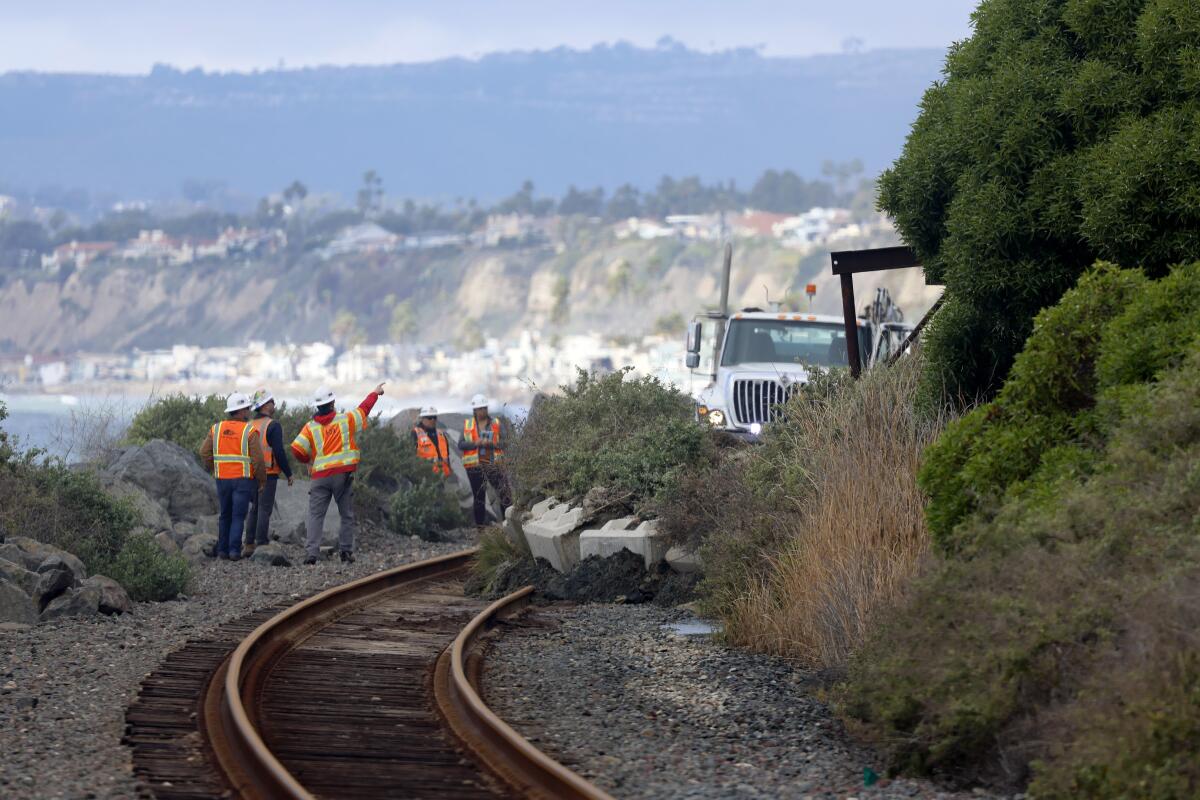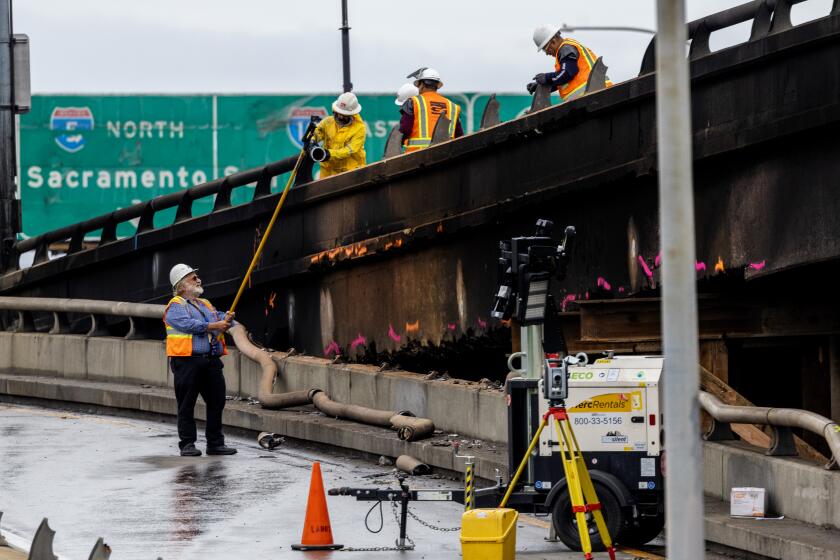To save its coastal rail line, California will need to move it away from the ocean

- Share via
The nation’s second-busiest intercity passenger train line is partially closed. Again.
A landslide in San Clemente has stopped rail service indefinitely between Orange and San Diego counties, a key segment of the 351-mile coastal rail corridor that runs between San Luis Obispo, Los Angeles and San Diego.
This is the fifth time in three years that train service has been interrupted by hillside erosion in the area, upending people’s commutes, long-distance trips and freight movement along this important route. The track was closed to Amtrak’s Pacific Surfliner and Metrolink trains for six months last year. And with climate change fueling more intense storms, coastal erosion and sea level rise, closures of the ocean-side rail line are expected to become a regular occurrence.
It’s time for Californians and transportation officials to face the inevitable reality: Saving the coastal line means moving it away from the unstable land of the ocean’s edge.
The rapid fix of the damaged highway in downtown L.A. shows what’s possible when leaders put their energy, personnel and funding toward quick results.
State and local authorities were quick to declare a state of emergency this month, freeing up to $10 million in funding to stabilize the hillside. But that’s a temporary repair. There is far less momentum and progress toward a necessary and permanent fix, which will probably include moving portions of the tracks inland, away from the crumbling coastline.
Lawmakers, along with transit and environmental advocates, warn the Lossan rail corridor — which stands for Los Angeles-San Diego-San Luis Obispo — is facing an existential crisis. Ridership is down to 4 million passengers from a peak of 8 million before the pandemic, and the increasing service suspensions are undermining its reliability and desirability as an alternative to driving. The line is also a crucial freight corridor, moving a billion dollars’ worth of goods each year, and connects military bases in the state, including Vandenberg Space Force Base and Camp Pendleton.
Editorial: Funding for California’s bullet trains puts the high-speed rail revolution back on track
The Biden administration’s $6-billion investment in high-speed rail lines in California and Nevada is a big step toward building a clean, fast rail network for the rest of the nation.
Last month, lawmakers sent a letter to Gov. Gavin Newsom’s administration urging that the California State Transportation Agency take the lead in managing the rail line and charting a path forward.
The success of the rail line has been hampered by the lack of clear leadership, which is shared by five public transportation agencies and two private freight railroads, all of which have different priorities. Plus, the many cities and private property owners adjacent to the rail line have their own opinions on what should be done and who should pay for it. There isn’t a single overarching authority elevating what’s good for California’s future over parochial interests.
“There is a crisis happening along this rail line and it hasn’t gotten the attention it deserves,” said Sen. Catherine Blakespear (D-Encinitas), who is chair of a Senate subcommittee looking at how to fix the struggling rail line. “I don’t just want it to not fail. I want it to thrive.”
Twenty-five participants in a journalism fellowship in L.A. used Metro buses and trains to get to multiple meetings a day for a week. Safely. Happily. And on time.
All Californians should want that too. There is tremendous potential. Just look at Amtrak’s service between Washington, D.C., and Boston. It had 12 million passenger trips last year and is considered such an essential economic engine for the region that the Biden administration awarded $16.4 billion to fund 25 projects on the route.
There are more than 14 million residents in the region served by the coastal rail line, many of whom would relish the chance to take a fast, comfortable train between, say, Los Angeles and San Diego, rather than slog through traffic on Interstate 5. But prolonged track closures, unreliable and infrequent service, especially outside of commuter hours, disconnected ticketing systems and the lack of transit connections at stations all make the train a hard sell in Southern California.
Making the coastal rail corridor safe and successful will not be cheap, easy or fast. It could cost upward of $5 billion to relocate portions of the Orange County rail line inland and $4 billion to move tracks off the eroding cliffs in Del Mar. There are additional track and infrastructure projects needed so trains can operate more frequently and passengers can seamlessly transfer from train to train.
The work will take decades. That’s why it is important to accelerate the planning and set priorities now. We know what climate change will do to the coastline in the coming years. And we know what we have to do to ensure California doesn’t lose this essential rail connection.
More to Read
A cure for the common opinion
Get thought-provoking perspectives with our weekly newsletter.
You may occasionally receive promotional content from the Los Angeles Times.












